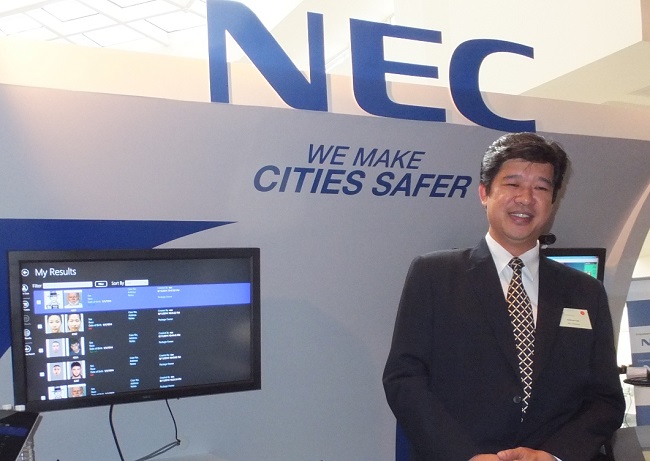NEC rolls out transportation solutions in Malaysia
By Lum Ka Kay November 19, 2015
- Hopes to bring greater mobility to Malaysian commuters
- Solutions cover highways, railways and bus systems

NEC Corporation of Malaysia Sdn Bhd has launched its transportation solutions, part of its public safety offerings.
These technologies can be used to manage key infrastructure such as railways, highways, and bus networks, to make every commuter’s journey safer and smoother, said its managing director Andrew Lee (pic above).
“We are ready to offer solutions that best fit to the Malaysian market, from our global experiences,” he said at the launch in Kuala Lumpur on Nov 17.
When asked how NEC sets itself apart from its competitors, Lee said: “I believe every company has its strengths and unique value propositions.
“At NEC, our expertise lies in surveillance and security, as well as communications,” he added.
The Malaysian Government has included infrastructure improvement as one of the measures to strengthen the country’s economic resilience, in its national Budget 2016, noted Chuah Yeow Chiang, division manager of NEC Malaysia’s public safety and social infrastructure division.
He said this provides an opportunity for NEC to step in and offer its intelligent solutions to further improve Malaysia’s transportation systems.
In Budget 2016, a total amount of RM30.1 billion was allocated for the economic sector which includes infrastructure, industrial and rural development.
Highways, buses and railways

For highway users, NEC transportation control system distributes information on road conditions, including vehicle passenger information from road traffic measurement sensors; weather information from weather sensors; videos from closed-circuit television (CCTV) surveillance cameras; as well as emergency telephone and cellphone calls from highway users.
Chuah claimed this control system can be used to divert traffic to reduce traffic congestion along affected routes.
“During traffic jams, CCTV cameras can detect the situation and the information will be analysed at the command centre and then displayed on the highway information board – or even through FM radio broadcasts to alert drivers to travel via a different route,” he said.
For railways, Chuah said NEC’s focus is on communications and security.
“There are wired and wireless solutions for train-to-train and train-to-station communications.
“As for the security part, images captured via CCTV cameras at stations and in the trains will be sent back to the data centre for analysis.
“To combat the rise in terror attacks on public transport networks, the NEC system also manages on-train security, which allows authorities to improve security and communication on mass-transit systems,” he said.
Chuah said another feature that NEC can provide is an automated fare collection system (AFC).
Citing Japan’s cashless rail pass Suica as an example, he said NEC aims to provide a more seamless AFC system for railway systems in Malaysia.
“For example, in Tokyo, it takes less than one second for a commuter to pass through the ticketing gate. But in Malaysia, it takes about three to five seconds.
“So we hope to bring this technology to Malaysia where commuters are able to enjoy this seamless experience,” he said.
To enhance bus networks, Chua said NEC’s bus intelligent system leverages on telematics fleet management systems built into the information technology (IT) infrastructure.
The system, which tracks driving behaviour, will help improve passenger safety as the data collected will be used to identify high-risk driving behaviour, he said.
 “The eco-drive sensors will monitor and analyse driving behaviour and indicate when a bus driver accelerates or decelerates quickly or changes lanes abruptly, and also provide visual cues for bus drivers to adjust their driving speed.
“The eco-drive sensors will monitor and analyse driving behaviour and indicate when a bus driver accelerates or decelerates quickly or changes lanes abruptly, and also provide visual cues for bus drivers to adjust their driving speed.
“The performance data of each bus will be transmitted to a real-time centralised tracking software solution monitored at the bus depot command centre via GPS (Global Positioning System),” said Chuah (pic).
NEC said its fleet management system solution can also help tackle a common issue at Malaysia’s bus stops – ‘bunching,’ when two or more buses serving the same route arrive at the same stop at the same time.
“The system manages the operations and monitors bus location data via GPS, and dead reckoning algorithms which provide real-time bus tracking and help in the distribution of buses,” said Chuah.
“A signal will be sent to the command centre to adjust the bus schedules to avoid bunching,” he added.
Related Stories:
NEC develops crime-fighting and bus scheduling technologies
NEC in smart energy partnership with Singapore’s Economic Development Board
NEC Corp inks distribution deal with Springlab
Katsana combines GPS with behavioural data to help motor insurers
For more technology news and the latest updates, follow us on Twitter, LinkedIn or Like us on Facebook.


